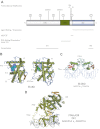Allosteric modulators of steroid hormone receptors: structural dynamics and gene regulation
- PMID: 22433123
- PMCID: PMC3596562
- DOI: 10.1210/er.2011-1033
Allosteric modulators of steroid hormone receptors: structural dynamics and gene regulation
Abstract
Steroid hormones are synthesized from cholesterol primarily in the adrenal gland and the gonads and play vital roles in normal physiology, the control of development, differentiation, metabolic homeostasis, and reproduction. The actions of these small lipophilic molecules are mediated by intracellular receptor proteins. It is just over 25 yr since the first cDNA for steroid receptors were cloned, a development that led to the birth of a superfamily of ligand-activated transcription factors: the nuclear receptors. The receptor proteins share structurally and functionally related ligand binding and DNA-binding domains but possess distinct N-terminal domains and hinge regions that are intrinsically disordered. Since the original cloning experiments, considerable progress has been made in our understanding of the structure, mechanisms of action, and biology of this important class of ligand-activated transcription factors. In recent years, there has been interest in the structural plasticity and function of the N-terminal domain of steroid hormone receptors and in the allosteric regulation of protein folding and function in response to hormone, DNA response element architecture, and coregulatory protein binding partners. The N-terminal domain can exist as an ensemble of conformers, having more or less structure, which prime this region of the receptor to rapidly respond to changes in the intracellular environment through hormone binding and posttranslation modifications. In this review, we address the question of receptor structure and function dynamics with particular emphasis on the structurally flexible N-terminal domain, intra- and interdomain communications, and the allosteric regulation of receptor action.
Figures





Similar articles
-
Structural and functional relationships of the steroid hormone receptors' N-terminal transactivation domain.Steroids. 2009 Nov;74(12):877-83. doi: 10.1016/j.steroids.2009.07.012. Epub 2009 Aug 8. Steroids. 2009. PMID: 19666041 Free PMC article. Review.
-
Structural dynamics, intrinsic disorder, and allostery in nuclear receptors as transcription factors.J Biol Chem. 2011 Nov 18;286(46):39675-82. doi: 10.1074/jbc.R111.278929. Epub 2011 Sep 21. J Biol Chem. 2011. PMID: 21937423 Free PMC article. Review.
-
Structure and function of steroid receptor AF1 transactivation domains: induction of active conformations.Biochem J. 2005 Nov 1;391(Pt 3):449-64. doi: 10.1042/BJ20050872. Biochem J. 2005. PMID: 16238547 Free PMC article. Review.
-
Using intrinsic fluorescence emission spectroscopy to study steroid receptor and coactivator protein conformation dynamics.Methods Mol Biol. 2009;505:205-18. doi: 10.1007/978-1-60327-575-0_12. Methods Mol Biol. 2009. PMID: 19117147
-
Nuclear receptors: one big family.Methods Mol Biol. 2009;505:3-18. doi: 10.1007/978-1-60327-575-0_1. Methods Mol Biol. 2009. PMID: 19117136 Review.
Cited by
-
Engineering Allostery into Proteins.Adv Exp Med Biol. 2019;1163:359-384. doi: 10.1007/978-981-13-8719-7_15. Adv Exp Med Biol. 2019. PMID: 31707711 Free PMC article. Review.
-
Role of Phosphorylation in the Modulation of the Glucocorticoid Receptor's Intrinsically Disordered Domain.Biomolecules. 2019 Mar 11;9(3):95. doi: 10.3390/biom9030095. Biomolecules. 2019. PMID: 30862072 Free PMC article. Review.
-
Regulation of the structurally dynamic N-terminal domain of progesterone receptor by protein-induced folding.J Biol Chem. 2013 Oct 18;288(42):30285-30299. doi: 10.1074/jbc.M113.491787. Epub 2013 Aug 30. J Biol Chem. 2013. PMID: 23995840 Free PMC article.
-
Chemical Screening of Nuclear Receptor Modulators.Int J Mol Sci. 2020 Jul 31;21(15):5512. doi: 10.3390/ijms21155512. Int J Mol Sci. 2020. PMID: 32752136 Free PMC article. Review.
-
Solution Behavior of the Intrinsically Disordered N-Terminal Domain of Retinoid X Receptor α in the Context of the Full-Length Protein.Biochemistry. 2016 Mar 29;55(12):1741-1748. doi: 10.1021/acs.biochem.5b01122. Epub 2016 Mar 15. Biochemistry. 2016. PMID: 26937780 Free PMC article.
References
-
- Gronemeyer H, Gustafsson JA, Laudet V. 2004. Principles for modulation of the nuclear receptor superfamily. Nat Rev Drug Discov 3:950–964 - PubMed
-
- Yang X, Lamia KA, Evans RM. 2007. Nuclear receptors, metabolism, and the circadian clock. Cold Spring Harb Symp Quant Biol 72:387–394 - PubMed
-
- McEwan IJ. 2009. Nuclear receptors: one big family. Methods Mol Biol 505:3–18 - PubMed
-
- Stanisiæ V, Lonard DM, O'Malley BW. 2010. Modulation of steroid hormone receptor activity. Prog Brain Res 181:153–176 - PubMed
Publication types
MeSH terms
Substances
Grants and funding
LinkOut - more resources
Full Text Sources
Other Literature Sources
Molecular Biology Databases

